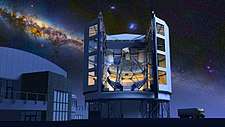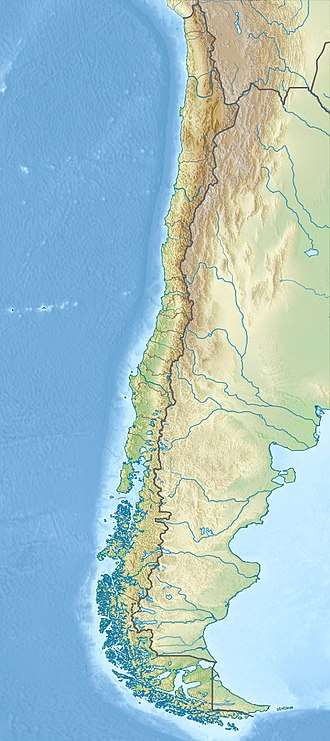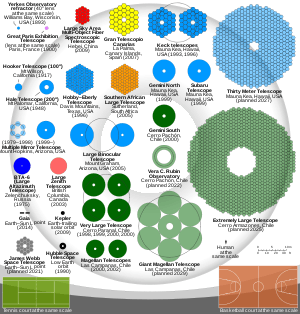Giant Magellan Telescope
The Giant Magellan Telescope (GMT) is a ground-based extremely large telescope under construction. It will consist of seven 8.4 m (27.6 ft) diameter primary segments,[1] that will observe optical and near infrared (320–25000 nm[2]) light, with the resolving power of a 24.5 m (80.4 ft) primary mirror and collecting area equivalent to a 22.0 m (72.2 ft) one,[3] which is about 368 square meters.[4] The telescope is expected to have a resolving power 10 times greater than the Hubble Space Telescope. As of November 2017, five mirrors had been cast and the construction of the summit facility has begun.[5][6][7]
 Artwork of Giant Magellan Telescope | |
| Alternative names | GMT |
|---|---|
| Part of | Las Campanas Observatory |
| Location(s) | Vallenar, Trehuaco, Huasco Province, Atacama Region, Chile |
| Coordinates | 29°01′54″S 70°41′01″W |
| Altitude | 2,516 m (8,255 ft) |
| Wavelength | 320 nm (940 THz)-25,000 nm (12 THz) |
| Built | 2015 |
| First light | 2029 |
| Telescope style | Gregorian telescope optical telescope |
| Diameter | 25.448 m (83 ft 5.9 in) |
| Secondary diameter | 3.2 m (10 ft 6 in) |
| Angular resolution | 0.01 arcsecond |
| Collecting area | 368 m2 (3,960 sq ft) |
| Focal length | 18, 202.7 m (59 ft 1 in, 665 ft 0 in) |
| Mounting | altazimuth mount |
| Website | www |
 Location of Giant Magellan Telescope | |
A total of seven primary mirrors are planned, but it will begin operation with four.[8][9] The $1 billion project is US-led in partnership with Australia, Brazil, and South Korea, with Chile as the host country.
Site
The location of the telescope is Las Campanas Observatory,[10] which is also the site of the Magellan Telescopes, some 115 km (71 mi) north-northeast of La Serena, Chile and 180 km (112 mi) south of Copiapó, Chile, at an altitude of 2,516 m (8,255 ft).[11][12] The site has been chosen as the new instrument's location because of its outstanding astronomical seeing and clear weather throughout most of the year.[13] Moreover, due to the sparsity of population centers and other favorable geographical conditions, the night sky in most of the surrounding Atacama Desert region is not only free from atmospheric pollution, but in addition it is probably one of the places least affected by light pollution, making the area one of the best spots on Earth for long-term astronomical observation. Major site preparation began with the first blast to level the mountain peak on 23 March 2012. In November 2015, construction was started at the site, with a ground-breaking ceremony.[5][6]
The excavation for the foundations was completed in early 2019.[14]
Mirrors


The telescope will use seven of the world's largest mirrors as primary mirror segments, each 8.417 m (27.61 ft) in diameter. These segments will then be arranged with one mirror in the center and the other six arranged symmetrically around it. The challenge is that the outer six mirror segments will be off-axis, and although identical to each other, will not be individually radially symmetrical, necessitating a modification of the usual polishing and testing procedures.[15]
The mirrors are being constructed by the University of Arizona's Steward Observatory Richard F. Caris Mirror Lab.[16] The casting of the first mirror, in a rotating furnace, was completed on November 3, 2005, but the grinding and polishing were still going on 6½ years later when the second mirror was cast, on 14 January 2012.[17][18] A third segment was cast in August 2013,[8][19] and the fourth in September 2015.[20] The casting of each mirror uses 20 tons of E6 borosilicate glass from the Ohara Corporation of Japan and takes about 12–13 weeks.[21] After being cast, they need to cool for about six months.[8]
Polishing of the first mirror was completed in November 2012.[22] As this was an off-axis segment, a wide array of new optical tests and laboratory infrastructure had to be developed to polish the mirror.
The intention is to build seven identical off-axis mirrors, so that a spare is available to substitute for a segment being recoated, a 1–2 week (per segment) process required every 1–2 years.[23] While the complete telescope will use seven mirrors, it is planned to begin operation with four mirrors.[8]
The primary mirror array as a whole will have a focal ratio (focal length divided by diameter) of f/0.71. For an individual segment – being one third that diameter – this results in a focal ratio of f/2.14.[19] The overall focal ratio of the complete telescope will be f/8 and the optical prescription is an aplanatic Gregorian telescope. Like all modern large telescopes it will make use of adaptive optics.[24][25]
Scientists expect very high quality images due to the very large aperture and advanced adaptive optics. Image resolution should exceed that of the Hubble Space Telescope.[26]
Support Structure
The telescope structure is an alt-azimuth design and it will stand on a pier that is 22 meters in diameter.[27]
In late October GMTO announced the signing of a contract with German company MT Mechatronics (subsidiary of OHB SE) and Illinois-based Ingersoll Machine Tools, to design, build and install the GMT’s telescope structure. The structure will weigh 1,800 tons without mirrors and instruments. With mirrors and instruments it will weigh 2,100 tons. This structure will float on a film of oil (50 microns thick), being supported by a number of hydrostatic bearings. The structure is expected to be delivered to Chile at the end of 2025.[28][29]
Wavefront Control & Adaptive Optics (AO)
The primary mirrors are housed inside a “cell” which protect the mirrors. Pneumatic actuators will push on the back of the primary mirrors to correct for the effects of gravity and temperature variations on the mirrors.[30]
The GMT’s Adaptive Optics system will be built into the secondary mirrors which will be deformable. The Adaptive Secondary Mirrors (or ASMs) consist of a thin sheet of glass that is bonded to more than 7000 independently controlled voice coil actuators. These actuators will be able to push and pull on the mirrors over 1000 times a second to correct for wavefront distortions introduced by turbulence in the Earth’s atmosphere.[31]
The GMT will have several types of adaptive optics. The Ground layer AO allows corrections over a large field of view (≥ 10 arcmin). The Natural Guide Star AO is needed to produce diffraction-limited corrections over a small field of view (20-30 arcseconds). The Laser Tomography AO uses six laser guide stars and a faint, natural guide star to extend diffraction-limited corrections to regions without a bright guide star. The performance will be similar to Natural Guide Star AO, but with reduced contrast.[31]
Science Instruments
The planned first light instruments are four instruments and one facility fiber positioning system.[32] The fiber positioning system is necessary because of the wide field of view of the GMT. Using this system it is possible to observe multiple targets over the entire field with one or more of the spectrographs.[33]
- GMT-Consortium Large Earth Finder (G-CLEF) - a visible echelle spectrograph[34]
- GMT Multi-object Astronomical and Cosmological Spectrograph (GMACS) - a visible multi-object spectrograph[35]
- GMT Integral-Field Spectrograph (GMTIFS) - a near-IR IFU and AO imager[36]
- GMT Near-IR spectrograph (GMTNIRS) - a near-IR spectrograph[37]
- The Many Instrument Fiber System (MANIFEST) - a facility fiber system[38]
Additionally the Commissioning Camera (ComCam) will be used to validate the Ground Layer Adaptive Optics performance of the GMT facility Adaptive Optics System.[39]
Comparison
The Giant Magellan Telescope is one of a new class of telescopes called extremely large telescopes with each design being much larger than previous telescopes.[40] Other planned extremely large telescopes include the Extremely Large Telescope and the Thirty Meter Telescope.[41]
| Name | Aperture diameter (m) | Collecting area (m²) | First light |
|---|---|---|---|
| Extremely Large Telescope (ELT) | 39.3 | 978 | 2025 |
| Thirty Meter Telescope (TMT) | 30 | 655 | 2027[42] |
| Giant Magellan Telescope (GMT) | 24.5 | 368 | 2029[43] |
| Southern African Large Telescope (SALT) | 11.1 × 9.8 | 79 | 2005 |
| Keck Telescopes | 10.0 | 76 | 1990, 1996 |
| Gran Telescopio Canarias (GTC) | 10.4 | 74 | 2007 |
| Very Large Telescope (VLT) | 8.2 | 50 | 1998-2000 |
| Notes: future dates for first-light are provisional and are likely to change. | |||
Organizations
The project is US-led in partnership with Australia, Brazil, and South Korea, with Chile as the host country.[5] The following organizations are members of the consortium developing the telescope.[44]
- University of Arizona (Department of Astronomy and Steward Observatory)
- Arizona State University (School of Earth and Space Exploration (SESE))
- Astronomy Australia Limited
- Australian National University (Research School of Astronomy and Astrophysics)
- Carnegie Observatories
- University of São Paulo (São Paulo Research Foundation – FAPESP)
- Harvard University (jointly; Harvard-Smithsonian Center for Astrophysics (CfA))
- Korea Astronomy and Space Science Institute (한국천문연구원) (KASI)
- The Smithsonian Institution (jointly; Harvard-Smithsonian Center for Astrophysics (CfA))
- Texas A&M University
- University of Texas at Austin (Department of Astronomy at the University of Texas at Austin)
- University of Chicago (Astronomy & Astrophysics Department of the University of Chicago)
The Carnegie Observatories office in Pasadena has an outline of the GMT primary mirror array painted in its parking lot. It is easily visible in satellite imagery at 34.15591°N 118.13345°W. In January 2018, WSP was awarded the contract to manage construction of the GMT.[45]
Status of mirrors
There will be a total of eight primary mirror segments: one central mirror, six off-axis segments,[46] and a spare off-axis segment[47] which will be rotated into use as each segment is cleaned and recoated. The mirrors are made of borosilicate glass and have a honeycomb structure below the mirror surface.[46] An adaptive secondary mirror is also designed for the telescope.[46] The telescope will begin observing with only four mirrors: the central and three off-axis segments.[9]
- Mirror 1, cast in October 2005,[21] completed in August 2012 with polishing completed with a surface accuracy of 19 nanometers RMS.[22]
- Mirror 2, cast in January 2012.[21] completed in 2019.[48]
- Mirror 3, cast in August 2013.[8][21] currently undergoing fine grinding of its front surface.[49]
- Mirror 4, cast in September 2015,[20] This is the central mirror.[9] Currently the rear surface is polished and is having its load spreaders installed. [50]
- Mirror 5, cast in November 2017.[51]
- Mirror 6, in early construction phase. Planned to be casted in 2020. [52]
- Mirror 7, in planning, will be casted in 2021.[53]
- Mirror 8, not yet planned.
See also
References
- "Giant Magellan Telescope Partner Institutions". GMT Consortium. Archived from the original on 2007-02-11. Retrieved 2007-04-03.
- "Giant Magellan Telescope Science Requirements" (PDF). GMT Consortium. p. 11. Retrieved 2008-03-31.
- Maggie McKee (2007-10-04). "Giant telescope in race to become world's largest". New Scientist. Retrieved 2007-10-07.
- "Chapter 6: Optics". GMT Conceptual Design Report. GMT Consortium. p. 6–3. Archived from the original (PDF) on 2011-06-09. Retrieved 2008-04-02.
- Amos, Jonathan (12 November 2015). "Giant Magellan Telescope: Super-scope project breaks ground". BBC News. Retrieved 2015-11-15.
- The Giant Magellan Telescope Organization Breaks Ground in Chile
- Harvard Magazine - Giant Magellan Milestone (2013)
- Hutchins, Shana K. (September 18, 2015). "Giant Magellan Telescope to Cast Milestone Fourth Mirror". Texas A&M Today. Archived from the original on October 4, 2017. Retrieved 2015-12-17.
There is special significance to the fourth mirror. It will be the central unit. Without it, the other mirrors would be much more difficult to bring together to function as a single telescope. Also, our baseline plan starts the operations of the GMT with just these four mirrors, which will all have been cast once this one is complete.
- "Giant Magellan telescope site selected". Carnegie Institution. Retrieved 2007-10-05.
- José Terán U.; Daniel H. Neff; Matt Johns (2006-05-29). Conceptual design study of the GMT enclosure (PDF). SPIE 6267: Symposium on Astronomical Telescopes and Instrumentation. Orlando, Florida: SPIE. p. 2. Retrieved 2008-03-31.
- Joanna Thomas-Osip (2007-03-20), "The Seeing and Turbulence Profile at Las Campanas Observatory: GMT Site Testing Progress Report" (PDF), Syposium on Seeing, Kona, Hawaii: AAS, p. 3, retrieved 2008-03-31
- Robinson, Travis (2007-04-03). "Eye on the sky". The Battalion. Archived from the original on 2007-09-29. Retrieved 2007-04-03.
- https://www.gmto.org/2019/03/excavation-of-gmt-pier-and-enclosure-foundations-complete/
- What is Optical Metrology?, GMTO, archived from the original on 2012-03-28, retrieved 2012-04-08
- https://mirrorlab.arizona.edu
-
Ketelsen, Dean (2012-01-15), GMT polishing at Mirror Lab open house 14 Jan, 2012, retrieved 2012-04-08,
While guests toured the facilities, the Lab staff ran both of our polishing machines on current projects, including this view of final polishing on the first GMT segment.
- "Mirror Casting Event for the Giant Magellan Telescope" (Press release). GMTO. 2012-01-09. Archived from the original on 2012-04-11.
- Steward Observatory Mirror Lab, Mirror Castings, archived from the original on 2012-06-23, retrieved 2012-04-08
- "Richard F. Caris Mirror Lab Casts Fourth GMT Segment" (Press release). GMTO. September 18, 2015.
- Mittan, Kyle (2012-01-16). "Steward Observatory casts second mirror for Giant Magellan Telescope". The Daily Wildcat.
- "World's Most Advanced Mirror for Giant Telescope Completed". Australian National University. 2012-11-09. Archived from the original on 2013-03-14. Retrieved 2012-01-14.
-
"Telescope Structure". GMT Conceptual Design Report. February 2006. p. 7-17 § 7.4.5. Archived from the original (PDF) on 2012-03-28. Retrieved 2007-10-07.
The center segment and cell will not have a spare, thus observations will be interrupted every one or two years for the 1–2 week period required to recoat that mirror.
-
"Chapter 2: Overview", GMT Conceptual Design Report, 2006, p. 2-4 § 2.5.1, archived from the original (PDF) on 2012-03-28, retrieved 2012-03-25,
GMT is designed from the outset around adaptive optics (AO) with the goal of producing diffraction limited images at 1 μm and longer wavelengths.
- Hippler, Stefan (2019). "Adaptive Optics for Extremely Large Telescopes". Journal of Astronomical Instrumentation. 8 (2): 1950001–322. arXiv:1808.02693. Bibcode:2019JAI.....850001H. doi:10.1142/S2251171719500016.
- Amos, Jonathan (3 June 2015). "Magellan super-scope gets green light for construction". BBC News. Retrieved 2015-06-04.
- "Science and Technology | Giant Magellan Telescope". Retrieved 2020-01-04.
- "Giant Magellan Telescope signs contract for telescope structure | Giant Magellan Telescope". Retrieved 2020-01-04.
- "December 2019 | Giant Magellan Telescope". Retrieved 2020-01-04.
- "Science and Technology | Giant Magellan Telescope | Wavefront Control". Retrieved 2020-01-04.
- "Science and Technology | Giant Magellan Telescope | Adaptive Optics". Retrieved 2020-01-04.
- "Science and Technology | Giant Magellan Telescope | Science Instruments". Retrieved 2020-01-04.
- "Facility Fiber Optics Positioner – MANIFEST | Giant Magellan Telescope". Retrieved 2020-01-04.
- "G-CLEF – The GMT-Consortium Large Earth Finder". gclef.cfa.harvard.edu. Retrieved 2020-01-04.
- "GMACS -Texas A&M Astronomical Instrumentation". Texas A&M University, College Station, TX.
- Director, RSAA; webmaster@mso.anu.edu.au. "Giant Magellan Telescope Integral-Field Spectrograph (GMTIFS)". rsaa.anu.edu.au. Retrieved 2020-01-04.
- "GMTNIRS". www.as.utexas.edu. Retrieved 2020-01-04.
- "MANIFEST | Australian Astronomical Observatory". Australian Astronomical Observatory.
- "Commissioning Camera – ComCam | Giant Magellan Telescope". Retrieved 2020-01-04.
- "GMT Overview -- Giant Magellan Telescope". Archived from the original on 2011-06-09. Retrieved 2011-06-15.
- "About TMT -- Thirty Meter Telescope". Archived from the original on 2011-08-08. Retrieved 2011-06-15.
- TMT Timeline, accessed February 11, 2018
- "Giant Magellan Telescope - Quick Facts". Retrieved 16 November 2019.
- "Founders | Giant Magellan Telescope". GMTO Corporation. Retrieved 2018-02-11.
- "Giant Magellan Telescope Organization names WSP as Construction Manager". www.gmto.org. January 11, 2018. Retrieved 2018-01-25.
- Giant Magellan Telescope - Overview
- Martina, H. M.; Burgea, J. H.; Davisa, J. M.; Kimb, D. W.; Kingsleya, J. S.; Lawa, K.; Loeffa, A.; Lutza, R. D.; Merrilla, C.; Strittmattera, P. A.; Tuella, M. T.; Weinbergera, S. N.; Westa, S. C. (22 July 2016). "Status of mirror segment production for the Giant Magellan Telescope" (PDF). In Navarro, Ramón; Burge, James H. (eds.). Advances in Optical and Mechanical Technologies for Telescopes and Instrumentation II. SPIE Astronomical Telescopes + Instrumentation. Proc. SPIE. 9912. Edinburgh. p. 99120V. doi:10.1117/12.2234491. hdl:10150/622425.
- "GMT FREQUENTLY ASKED QUESTIONS". GMT FAQ, 2019.
- "GMT FREQUENTLY ASKED QUESTIONS". GMT FAQ, 2019.
- "GMT FREQUENTLY ASKED QUESTIONS". GMT FAQ, 2019.
- "GMT FREQUENTLY ASKED QUESTIONS". GMT FAQ, 2019.
- "GMT FREQUENTLY ASKED QUESTIONS". GMT FAQ, 2019.
- "GMT FREQUENTLY ASKED QUESTIONS". GMT FAQ, 2019.
External links
- Giant Magellan Telescope home page
- Lecture by director Patrick McCarthy on technologies behind GMT
- Article from the MIT news office
- New Scientist article on the telescope
- COSMOS article on the telescope
- Painted outline of the mirrors at the parking lot of the Observatories of the Carnegie Institution in Pasadena
- J. Rosenberg - Seeing Stars (2013) - Harvard Magazine
- J. Davis - Making mirrors for the Giant Magellan Telescope (2013) - The Planetary Society
